Keith Ducklin, Royal
Armoruies Workshop with ARMA
March 11, 2000, Houston, Texas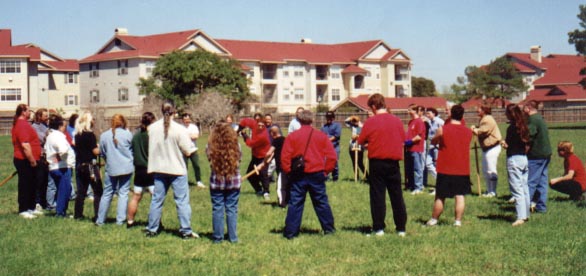
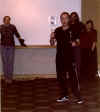 On Saturday, March 11, 2000, Houston ARMA (at the time
"HACA") sponsored a special one-day seminar featuring Keith Ducklin,
Senior Fight Interpreter of the Royal Armories in Leeds, England. Mr. Ducklin gave a rare
workshop on the John Waller Method of Historical Fencing. This unique event focused
on unarmored Great-Sword followed by Armored Great-Sword, and then basic rapier &
dagger. This was one of only two unique workshops Mr. Ducklin, recently featured on The
History Channel’s Arms in Action series, gave in America during the year 2000
(his first trip to the US). It was an unprecedented opportunity to see first hand the
Royal Armouries’ method and receive hands-on instruction in person. On Saturday, March 11, 2000, Houston ARMA (at the time
"HACA") sponsored a special one-day seminar featuring Keith Ducklin,
Senior Fight Interpreter of the Royal Armories in Leeds, England. Mr. Ducklin gave a rare
workshop on the John Waller Method of Historical Fencing. This unique event focused
on unarmored Great-Sword followed by Armored Great-Sword, and then basic rapier &
dagger. This was one of only two unique workshops Mr. Ducklin, recently featured on The
History Channel’s Arms in Action series, gave in America during the year 2000
(his first trip to the US). It was an unprecedented opportunity to see first hand the
Royal Armouries’ method and receive hands-on instruction in person.
 Among the 62 attendees the variety present was noticeable.
Many attendees were from Texas and Louisiana, but a few came from as far as Arizona and
Nevada. The workshop brought together western martial artists, historical reenactors, and
fight directors to witness one of the expertise of the Royal Armouries Fight
Interpretation Team. The seminar validated the importance of combining the academic
research into those manuals with the physical application of those techniques in free-play
sparring and training exercises as the only means of truly understanding the historical
masters’ intent. Mr. Ducklin distinguished between historical fencing and arranged
performance fighting, and also emphasized that it is possible to perform an entertaining
and exciting theatrical combat presentation while still adhering and displaying the proper
effective techniques detailed by manuals and the actual handling qualities of real
weapons. He first covered general principles of the Waller method as used at the
Armouries, then provided demonstrations and instruction on techniques. This was followed
by a safe, fluid, and yet arranged combat routine based upon them. Among the 62 attendees the variety present was noticeable.
Many attendees were from Texas and Louisiana, but a few came from as far as Arizona and
Nevada. The workshop brought together western martial artists, historical reenactors, and
fight directors to witness one of the expertise of the Royal Armouries Fight
Interpretation Team. The seminar validated the importance of combining the academic
research into those manuals with the physical application of those techniques in free-play
sparring and training exercises as the only means of truly understanding the historical
masters’ intent. Mr. Ducklin distinguished between historical fencing and arranged
performance fighting, and also emphasized that it is possible to perform an entertaining
and exciting theatrical combat presentation while still adhering and displaying the proper
effective techniques detailed by manuals and the actual handling qualities of real
weapons. He first covered general principles of the Waller method as used at the
Armouries, then provided demonstrations and instruction on techniques. This was followed
by a safe, fluid, and yet arranged combat routine based upon them.
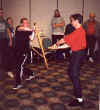 The event opened with John
Clements, Director of ARMA offering a welcome to everyone and an overview of the Royal
Armouries and their Fight Interpretation program, and then on the ARMA’s own premise
and methodology. After his opening remarks, Dr. Michael Lacy of Postern Tours gave
a short introduction on European arms & armor travel tours and his research. Michael
regularly volunteers at the Wallace Collection Museum in England. After this, Christian
Darce gave a quick introduction to Purpleheart Armouries wooden swords and wasters
and described their advantage for sword and dagger training. An additional merchant or two
was on hand to sell books and blades. A special video of the Royal Armories fight
interpretation team was then shown followed by Mr. Ducklin’s arrival. The event opened with John
Clements, Director of ARMA offering a welcome to everyone and an overview of the Royal
Armouries and their Fight Interpretation program, and then on the ARMA’s own premise
and methodology. After his opening remarks, Dr. Michael Lacy of Postern Tours gave
a short introduction on European arms & armor travel tours and his research. Michael
regularly volunteers at the Wallace Collection Museum in England. After this, Christian
Darce gave a quick introduction to Purpleheart Armouries wooden swords and wasters
and described their advantage for sword and dagger training. An additional merchant or two
was on hand to sell books and blades. A special video of the Royal Armories fight
interpretation team was then shown followed by Mr. Ducklin’s arrival.
 Mr. Ducklin began with some
rather flattering remarks on how impressed he was with the ARMA study approach and with
ARMA free-play (sparring) in particular. He then gave a brief introduction to the Waller
Method of Combat. Due to the size of the group and the limitations of the room, the
group was split into two sections. One went outside in an adjacent field to practice
great-sword techniques with Mr. Ducklin and the other group stayed inside for an
introduction to the ARMA approach to Rapier from Mr. Clements. It was a beautiful sunny
and cool Houston day outside, and Mr. Ducklin began by stating the base of four main
concepts that much of their swordplay is designed around: Always maintain eye contact;
Balance - always attack with the sword then with the body; At the beginning and end of
each move both feet should be firmly planted on the floor (not on the balls of your feet);
Intent - Know your intent and your opponents intent in order to coordinate techniques. Mr.
Ducklin’s basic great-sword sequence consisted of: Mr. Ducklin began with some
rather flattering remarks on how impressed he was with the ARMA study approach and with
ARMA free-play (sparring) in particular. He then gave a brief introduction to the Waller
Method of Combat. Due to the size of the group and the limitations of the room, the
group was split into two sections. One went outside in an adjacent field to practice
great-sword techniques with Mr. Ducklin and the other group stayed inside for an
introduction to the ARMA approach to Rapier from Mr. Clements. It was a beautiful sunny
and cool Houston day outside, and Mr. Ducklin began by stating the base of four main
concepts that much of their swordplay is designed around: Always maintain eye contact;
Balance - always attack with the sword then with the body; At the beginning and end of
each move both feet should be firmly planted on the floor (not on the balls of your feet);
Intent - Know your intent and your opponents intent in order to coordinate techniques. Mr.
Ducklin’s basic great-sword sequence consisted of:
Attacker (A) - Start with sword in shoulder, left foot forward, pass forward and attack
partners rear leg.
Counter Attacker (CA) - Passing traverse Hanging Block.
CA - Pass forward and attack rear leg.
A - Passing traverse Hanging Block.
A - Pass forward and cut straight down at head.
CA - Passing traverse with a slopping parry on the flat.
CA - Pass forward and horizontal cheek cut.
A - Pass back and high opposition parry with the edge of the ricasso.
A - Gleisarde and then thrust.
CA - Pass back and circular parry from above.
CA - Pass forward and cut straight down at head.
A - Pass back and high guard.
A - Pass forward, beat with guard and pommel strike to face.
 These actions were executed in order to keep most of the
action circular and allow the students to coordinate each of their attacks. Each attack
was to be done at a specific target in order for the opponent to counter it. Some attacks
were intentionally thrown slightly off-target for the sake of safety. At each of those
movements, Mr. Ducklin would first show the correct and proper target if fighting other
than for staged display –usually a little over or short of the person’s body. These actions were executed in order to keep most of the
action circular and allow the students to coordinate each of their attacks. Each attack
was to be done at a specific target in order for the opponent to counter it. Some attacks
were intentionally thrown slightly off-target for the sake of safety. At each of those
movements, Mr. Ducklin would first show the correct and proper target if fighting other
than for staged display –usually a little over or short of the person’s body.
 While Mr. Ducklin did his work, in the ballroom, Mr. Clements
held a brief introduction to the ARMA Rapier System, covering how the work of the Royal
Armouries and ARMA complimented one other. Going over the history, legends, and myths of
the weapon, as well as its geometry, he lectured on how a rapier really works, why was it
designed the way it was, and how it was employed in its particular context. He then went
over some of the basic techniques and some Gioco Stretto (close-play) and disarms. Matt
Hauser of Houston-ARMA got twisted up in a few knots helping in the demos and it all went
over very well. The distinct approach ARMA has toward the rapier as an urban
"fighting weapon" rather than just a aristocratic dueling tool was conveyed. The
traditionally ignored close-in techniques of rapier street-fighting, much pioneered by
ARMA, were emphasized. After the demo and discussions, since some members of the SCA as
well and others had as well as the ARMA had equipment, there was some brief time to cross
swords in free-play sparring. While Mr. Ducklin did his work, in the ballroom, Mr. Clements
held a brief introduction to the ARMA Rapier System, covering how the work of the Royal
Armouries and ARMA complimented one other. Going over the history, legends, and myths of
the weapon, as well as its geometry, he lectured on how a rapier really works, why was it
designed the way it was, and how it was employed in its particular context. He then went
over some of the basic techniques and some Gioco Stretto (close-play) and disarms. Matt
Hauser of Houston-ARMA got twisted up in a few knots helping in the demos and it all went
over very well. The distinct approach ARMA has toward the rapier as an urban
"fighting weapon" rather than just a aristocratic dueling tool was conveyed. The
traditionally ignored close-in techniques of rapier street-fighting, much pioneered by
ARMA, were emphasized. After the demo and discussions, since some members of the SCA as
well and others had as well as the ARMA had equipment, there was some brief time to cross
swords in free-play sparring.
 An open-invitation lunch was held at a nearby BBQ restaurant. Returning
afterwards, Mr. Ducklin came inside to begin his Rapier lesson while Mr. Clements went
outside to do ARMA long-sword demonstrations. The Waller rapier program had a similar
number of steps to the great-sword involved that required that involved both the attacker
and defender to do the proper sequence of moves. Since the room was not quite large
enough, about 8 pairs of students each practiced a few steps of the routine before
swapping off with the others. Some of these techniques involved some fancy footwork, but
most of the fighting was significantly more linear. A few harassing cuts were made while a
crossed sword and dagger parry counters that move. A kick to the legs was even done at one
time. In one encounter, an inexperienced student pierced another straight through the
finger with a just purchased sharp pointed rapier! An open-invitation lunch was held at a nearby BBQ restaurant. Returning
afterwards, Mr. Ducklin came inside to begin his Rapier lesson while Mr. Clements went
outside to do ARMA long-sword demonstrations. The Waller rapier program had a similar
number of steps to the great-sword involved that required that involved both the attacker
and defender to do the proper sequence of moves. Since the room was not quite large
enough, about 8 pairs of students each practiced a few steps of the routine before
swapping off with the others. Some of these techniques involved some fancy footwork, but
most of the fighting was significantly more linear. A few harassing cuts were made while a
crossed sword and dagger parry counters that move. A kick to the legs was even done at one
time. In one encounter, an inexperienced student pierced another straight through the
finger with a just purchased sharp pointed rapier!
   
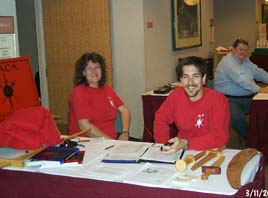 Outside,
to a group of about 15 attendees John Clements went over some of the long-sword guards,
cuts, thrusts, and counters as expressed in period manuals. He then instructed in basic
close-in Schwertnemen (sword-taking) techniques which made a big impression on the
students, demonstrating incorrect balance and at one point managed to remove a persons
shoe with a throw and then "attack" his "unarmored" foot! The classes
continued until about 4:30 pm and were followed by about 25 attendees went to a local
Mexican restaurant for discussions on swords, armour, and more swords with Mr. Ducklin,
who at one point retrieved a balloon sword and swung it around with a passion. Outside,
to a group of about 15 attendees John Clements went over some of the long-sword guards,
cuts, thrusts, and counters as expressed in period manuals. He then instructed in basic
close-in Schwertnemen (sword-taking) techniques which made a big impression on the
students, demonstrating incorrect balance and at one point managed to remove a persons
shoe with a throw and then "attack" his "unarmored" foot! The classes
continued until about 4:30 pm and were followed by about 25 attendees went to a local
Mexican restaurant for discussions on swords, armour, and more swords with Mr. Ducklin,
who at one point retrieved a balloon sword and swung it around with a passion.
 This was a rare chance to
meet Mr. Ducklin and experience his knowledge and expertise, witnessed the ARMA method
taught by John Clements, as well as gather and play with fellow historical swordplay
enthusiasts. The event was a popular success and will be followed up by future ARMA-Royal
Armoruies collaboration. This was a rare chance to
meet Mr. Ducklin and experience his knowledge and expertise, witnessed the ARMA method
taught by John Clements, as well as gather and play with fellow historical swordplay
enthusiasts. The event was a popular success and will be followed up by future ARMA-Royal
Armoruies collaboration.
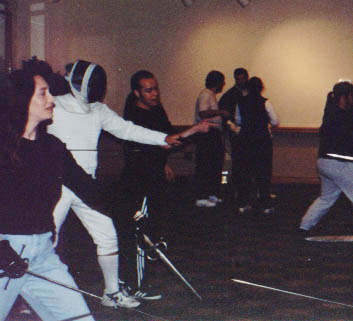
|

